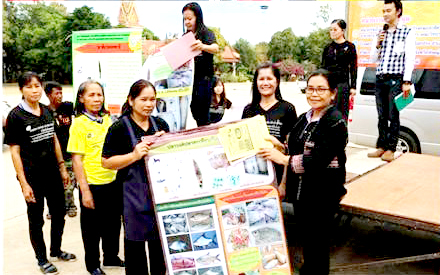Promoting O. viverini-free Traditional Food Consumption to Reduce Infection and Prevent Reinfection of O. viverrini in Khok Prong Sub-district, Phetchabun Province
Main Article Content
Abstract
Consumption of traditional raw food prepared from cyprinid fish including plara, plasom and pla jom has been reported a risk factor for Opisthorchis viverrini infection. The objectives of this project stressed 1) develop O. viverini-free traditional diets; 2) promote consumption of the O. viverini-free menu and health education and 3) evaluate the efficacy of this promotion in controlling infection and reinfection of O. viverini. This project was undertaken in Khok Prong sub-district, Wichian Buri district, Phetchabun province in 2015-2019. The procedure was divided into 3 phases: Phase 1 identifies risk factors and O. viverrini infection rate in the target sub-district, laboratory diagnosis for O. viverini infection, treatment of infected cases, and reports infection rates to community stakeholders and planning prevention and control policies. Phase 2 develops the O. viverini-free traditional menu suitable for the infected communities. Phase 3 determines infection and re-infection rates, measure changes in dietary behavior in the target group. The program achieved a reduced infection rate from 28.7% to 7.2%. Cooperative work and combination methods with campaigns for consuming parasite-free traditional meals reduced infection in high prevalence communities. Conclusion, consumption of a parasite-free traditional meal can have a major impact in controlling O. viverini in endemic areas where traditionally raw fish is preferred.
Article Details

This work is licensed under a Creative Commons Attribution-NonCommercial-NoDerivatives 4.0 International License.
Area Based Development Research Journal values copyright protection and licensing to safeguard author rights and facilitate the appropriate dissemination of research. Our policies ensure openness, accessibility, and attribution. Authors retain copyright ownership, and articles are published under a Creative Commons Attribution License (CC BY), allowing sharing, adaptation, and proper attribution. Authors have the freedom to publish under the CC BY license, granting broad reuse and distribution permissions. The journal supports posting articles on third-party repositories, adhering to institutional and funding restrictions. Author guidelines detail copyright and licensing requirements, empowering authors with knowledge about their rights and responsibilities. These policies cultivate an environment of collaboration, openness, and responsible sharing, benefiting authors and the research community while honoring intellectual property rights.
References
Charoensuk, L., Subrungruang, I., Mungthin, M., Pinlaor, S., & Suwannahitatorn, P. (2019). Comparison of stool examination techniques to detect Opisthorchis viverrini in low intensity infection. Acta Tropica, 191, 13-16.
Lindahl, J. F., & Grace, D. (2015). The consequences of human actions on risks for infectious diseases: a review. Infection Ecology and Epidemiology, 5, 30048.
Mard-arhin, N., Prawang, T., & Wongsawad, C. (2001). Helminths of freshwater animals from five provinces in northern Thailand. Southeast Asian Journal of Tropical Medicine and Public Health, 32(Suppl 2), 206-209.
Nithiuthai, S., Suwansaksri, J., Wiwanitkit, V., & Chaengphukeaw, P. (2002). A survey of metacercariae in cyprinoid fish in Nakhon Ratchasima, Northeast Thailand. Southeast Asian Journal of Tropical Medicine and Public Health, 33(Suppl 3), 103-105.
Prasongwatana, J., Laummaunwai, P., Boonmars, T., & Pinlaor, S. (2013). Viable metacercariae of Opisthorchis viverrini in northeastern Thai cyprinid fish dishes--as part of a rational program for control of O. viverrini-associated cholangiocarcinoma. Parasitology Research, 112(3), 1323-1327.
Pumidonming, W., Katahira, H., Igarashi, M., Salman, D., Abdelbaset, A. E., & Sangkaeo, K. (2018). Potential risk of a liver fluke Opisthorchis viverrini infection brought by immigrants from prevalent areas: A case study in the lower Northern Thailand. Acta Tropica, 178, 213-218.
Pumidonming, W., Poodendaen, C., Chulikorn, E., & Nateeworanart, S. (2006). The elimination of Opisthorchis viverrini in cyprinid fish used for traditional prepared foos. The 2nd Naresuan research conference: The success of the project development. Phitsanulok: Institute for Research and Development, Naresuan University. (In Thai).
R Core Team. (2015). R: A language and environment for statistical computing. R Foundation for statistical computing. Austria: Vienna.
Saengsawang, P., Promthet, S., & Bradshaw, P. (2016). Reinfection by Opisthorchis Viverrini after treatment with praziquantel. Asian Pacific Journal of Cancer Prevention, 17(2), 857-862.
Santos, F. L., Cerqueira, E. J., & Soares, N. M. (2005). Comparison of the thick smear and Kato-Katz techniques for diagnosis of intestinal helminth infections. Revista da Sociedade Brasileira de Medicina Tropical, 38(2), 196-198.
Sithithaworn, P., Andrews, R. H., Nguyen, V. D., Wongsaroj, T., Sinuon, M., Odermatt, P., ...Sripa, B. (2012). The current status of opisthorchiasis and clonorchiasis in the Mekong Basin. Parasitol Int, 61(1), 10-16.
Sithithaworn, P., & Haswell-Elkins, M. (2003). Epidemiology of Opisthorchis viverrini. Acta Tropica, 88(3), 187-194.
Sripa, B., Bethony, J. M., Sithithaworn, P., Kaewkes, S., Mairiang, E., Loukas, A., & Brindley, P. J. (2011). Opisthorchiasis and Opisthorchis-associated cholangiocarcinoma in Thailand and Laos. Acta Tropica, 120(Suppl 1), 158-168.
Sripa, B., Tangkawattana, S., & Sangnikul, T. (2017). The Lawa model: A sustainable, integrated opisthorchiasis control program using the EcoHealth approach in the Lawa Lake region of Thailand. Parasitology International, 66(4), 346-354.
Tatem, A. J., Rogers, D. J., & Hay, S. I. (2006). Global transport networks and infectious disease spread. Advances in Parasitology, 62, 293-343.
Wongratanacheewin, S., Pumidonming, W., Sermswan, R. W., Pipitgool, V., & Maleewong, W. (2002). Detection of Opisthorchis viverrini in human stool specimens by PCR. Journal of Clinical Microbiology, 40, 3879-3880.


